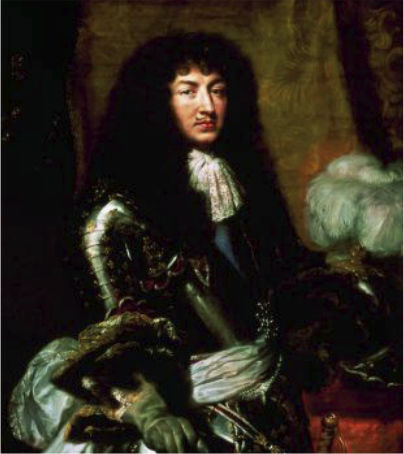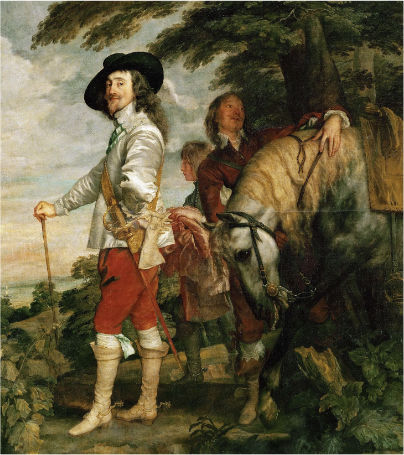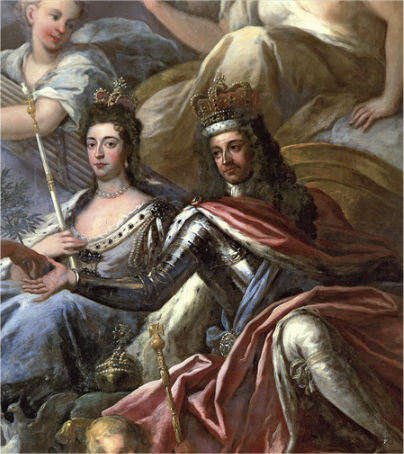The 18th century in Europe (the 17th century for England) was a period of deep changes that affected all aspects of life and decisively contributed to the forging of our contemporary world.
1. Absolute monarchies and Parliamentarianism
Since the late 15th century, the monarchs of Spain, France and England created centralized governments and bureaucracies able to limit the power of the aristocracy and to intervene in the international arena through a permanent royal army. New Modern States increased the collection of taxes and the efficiency of the financial State resources.
During the 17th century, Spain and France developed the principles of royal authority towards the so-called absolutism of the Crown, which was based on the divine right of the kings. Monarchs derived their power from God himself, and therefore, theoretically, there was no obstacle to the royal will. The model of royal absolutism was the French king Louis XIV,the roi soleil, who concentrated all the powers of the State in his court of Versailles. He meaningfully declared that l'état, c'est moi -I am myself the State, a phrase that summarizes the absolutist ideal. Nevertheless, England and the Unified Provinces (which emerged as an independent country during the war against Spain) evolved towards a new concept of State, the Constitutional State. In England, there was a confrontation between King Charles I Stuart and Parliament (1642-1649) that finished in the execution of the king and the dictatorship of Oliver Cromwell, leader of the Puritans (Civil War or First Revolution).

Wikimedia Commons

Wikimedia Commons
After the restoration of the Monarchy in 1660, the catholic king James II attracted widespread enmity and was consequently deposed by the Parliament in 1688 (the Second, or Glorious Revolution). In 1689 the new queen Mary, married to the ruler of the Low Countries, William, signed the Bill of Rights. It implied the limitation of the powers of the Crown and the right of Parliament to participate in the government. It was the beginning of a new form of political organization named Parliamentary Monarchy, where the king retained only the executive power and appointed the government. The power to make laws was in the hands of Parliament, whose members were elected through very limited suffrage.

Wikimedia Commons
Soon the political game was shared between two main political parties: the tories or conservatives and the wighs or liberals (bipartisanship). The main innovation of the new system lied on the fact that both the Crown and Parliament needed to cooperate to promote the common good.
2. The social and economic transformations of European society
The traditional European society (or old regime society, which refers to a time prior to the French Revolution) was rigidly divided into closed classes. Everybody belonged to a class since the moment of birth, and it was very difficult to move towards a better one. There were two main classes: the privileged minority (aristocracy and clergy, which enjoyed tax exemptions), and the unprivileged majority, which was borne the fiscal pressure. The latter was a heterogeneous group, although there were great differences between its members: the poorest of peasants had the same legal status as a wealthy businessman or a rich merchant.
However, there were changes. Whereas in certain countries (such as Spain), the aristocracy did not share the ideals and goals of the emergent bourgeoisie, and rejected a mentality based on economic profits, in England the nobility did not disdain to marry the members of the plebeian but wealthy groups. As a matter of fact, the bourgeois and aristocratic mentalities began to merge.
However, there were changes. Whereas in certain countries (such as Spain), the aristocracy did not share the ideals and goals of the emergent bourgeoisie, and rejected a mentality based on economic profits, in England the nobility did not disdain to marry the members of the plebeian but wealthy groups. As a matter of fact, the bourgeois and aristocratic mentalities began to merge.
The most important economic sector during the old regime was agriculture. Ownership of the land meant economic, social and political control, and therefore the biggest landlords belonged to the privileged group, whereas most peasants could only work on alien lands.
Industrial structure was manifold. The production of goods was mainly in the hands of craft guilds, which enjoyed labour and production monopolies. Theoretically, nobody could work in a craft unless being a member of the guild. Local authorities and guilds fixed prices and wages, and even regulated the number of goods and the quality of manufactures. The objective of this system was not to encourage production or to make profits, but the protection of the market. In parallel, some large manufactures were created to supply the needs of the royal palaces or the upper classes. The Crown could also grant trade or production privileges to certain influential persons.
Since the 17th century the development of capitalism transformed the European mentalities, economy and society. The need to increase production and the new objectives of wealth multiplication became increasingly incompatible with the rigid economic structure of the old regime.
The main factor for the emergence of an early capitalist society was international trade. English and Dutch merchants and manufacturers built networks of international trade, connecting all continents and making enormous profits. The development of trade encouraged the manufacture sector, since more products were required to be sold in distant markets. Colonial trade was based on a triangular link that connected Europe, Africa and America. Europe imported raw materials and coffee, tea, tobacco, cocoa or sugar from the colonies, and sent manufactures in exchange. Europeans also captured African slaves and sold them in America in order to make them work in the plantations.
3. Some 18th-century economic schools
Mercantilism. It was based on the idea according to which the wealth of a country lied on the accumulation of precious metals -gold and silver. When mines were not available, the State needed to create an industrial structure able to consolidate an intense export flow. Jean-Baptiste Colbert, minister of king Louis XIV of France, was one of the most prominent mercantilist figures.
Physiocracy. Mercantilism was soon superseded by physiocrats such as Turgot or de Gournay, who considered that the basis of the economy was agriculture (agricultural labour). Once agricultural activities were promoted, the other economic branches would grow accordingly.
The definition of economic liberalism: Adam Smith. Economic liberalism is based on the idea that private parties make their goods and services available on the free market in order to achieve a profit. Businessmen compete with each other, and prices and wages are determined by the forces of supply and demand, and not fixed by the authorities. In 1776, Adam Smith developed these ideas in his book The Wealth of Nations.
4. International affairs: the Seven Years' War (1756-1763)
It was called the first global war in history, since it involved four continents and most of European countries. One of the main reasons for the war was the imperial rivalry between France and Britain. French and British navies fought in India and, with the participation of Spain, also in America. However, the enmity between Austria (allied to France) and Prussia (allied to Great Britain) led to the outbreak of the war on the Continent.
The war finished with the Treaty of Paris (1763) signed by France, Spain and Great Britain, and Peace of Hubertusburg between Austria, Saxony and Prussia, which implied the victory of Great Britain and Prussia. All French territories in America (Canada, lands east of the Mississippi river) were transferred to Great Britain. Spain ceded Florida in exchange of Manila and Havana, although received Louisiana from the French in compensation. France lost all its colonies in India except five ports.
Even if the result of the war was highly favourable to Great Britain (which emerged as the world leading naval power) and to Frederick the Great's Prussia, the huge war expenditures led to a general financial crisis and had a direct impact on the American and French Revolutions.
